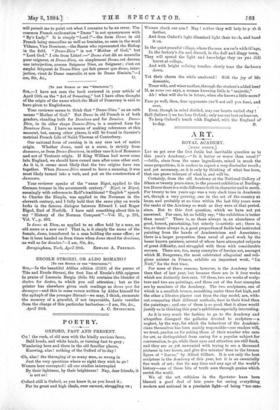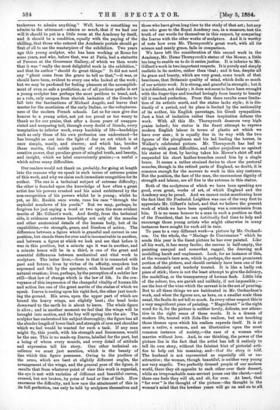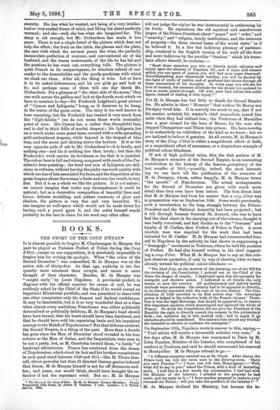ART.
LET us get over the first futile but inevitable question as to this year's Academy,—" Is it better or worse than usual ?" —futile, since from the same ingredients, mixed in much the same proportions, it is useless to expect a very dissimilar result ; and yet necessary, as it is only by thinking of what has been, that one grows tolerant of what is, and will be.
Certainly, from the old Academy at the National Gallery of fifteen or twenty years since, to the present exhibition at Burling- ton House there is a wide difference both in character and in merit. For twenty to ten years ago was a very slack time in Academic art, though a very growing. one in the art of the country at large, and probably at no time within the last fifty years were the ranks of the Academy so weak as they were at that period. since. But to this first question, which we have not yet answered. For once, let us boldly say, "the exhibition is better than usual." There is, as there always is, an abundance of good, honest, painstaking, but utterly in-artistic art ; there is, too, as there always is, a good proportion of feeble bat instructed painting from the hands of Academicians and Associates ; there is a larger proportion than usual of good work by the lesser known painters, several of whom have attempted subjects of great difficulty, and struggled with them with considerable success. There are, too, many examples of foreign art, amongst which M. Bougereau, the most celebrated allegorical and reli- gious painter in France, exhibits an important work, "La Nail," for the first time.
For none of these reasons, however, is the Academy better than that of last year, but because there are in it four works which are distinctly first-rate. Of these, two are works of sculp- ture and two are paintings, and three out of the four examples are by members of the Academy. The two sculptures, one of which is a smallish bronze, something under three feet high, and the other a life-sizo plaster cast from the clay model, are, with- out comparing their different methods, finer in their kind than the paintings ; and one of them is so good, that it alone would justify us in thinking this year's exhibition especially interesting.
As it is very much the fashion to go to the Academy and altogether disregard the galleries devoted to sculpture—a neglect, by the way, for which the behaviour of the Academi- cians themselves has been mainly responsible—our readers will, we trust, pardon us for asking those of their number who care for art, as distinguished from caring for a popular subject for conversation, to go, while their eyes and attention are still fresh, and they are as yet unwearied with trying to see a thousand pictures in two hours, and give five minutes' time to the bronze figure of "Icarus," by Alfred Gilbert. It is not only the best sculpture in the Academy of this year, but it is an essentially fine work of art ; fine for any time and any age of the world's history—one of those bits of truth seen through genius which enrich the world.
We of the art criticism in the Spectator have been blamed a good deal of late years for seeing everything modern and national in a pessimist light—of being "too can..
tankerous to admire anything." Well, here is something we admire to the uttermost—admire so much, that if we had our will it should be put in a little room at the Academy by itself, and it should be a condition, equally with the paying of the shilling, that those who entered the Academic portals should go first of all to see the masterpiece of the exhibition. Two years ago this young sculptor, who has been working at Rome for some years, and who, before that, was at Paris, had a statuette of Perseus at the Grosvenor Gallery, of which we then wrote that it was "really the most delightful work in the exhibition," and that its author "should do great things." It did not need any "ghost come from the grave to tell us that,"—it was, or should have been, evident to every one who looked at the work ; but we may be pardoned for feeling pleasure at the accomplish- ment of even so safe a prediction, as of all perilous paths in art a young sculptor has perhaps the most perilous to tread, and, as a rule, only escapes from slavish imitation of the Greeks to fall into the fascinations of Michael Angelo, and leaves that master for the asceticism of the early Italian, or the voluptuous- ness of the modern French schools. Let us for once give due honour to a young artist, not yet too proud or too weary to thank us for our praise, that after a dozen years of unappre- ciated and unsparing toil, through every doubt of friends, every temptation to inferior work, every hardship of life—hardships such as only those of his own profession can understand—he has brought us out into the light of day an art which is at once simple, manly, and sincere; and which has, besides these merits, that subtle quality of style, that touch of creative power, that peculiar grace of mingled truth, and beauty, and insight, which we label conveniently genius ;—a useful a., which solves many difficulties.
Our readers would not thank us, probably, for going at length into the reasons why we speak in such terms of extreme praise of this work, and why we claim such immediate recognition for its author. The one is a technical subject of extreme difficulty; the other is founded upon the knowledge of how often a great artist has his powers crushed and his mind embittered by the non-recognition of his powers whilst he is young ; whilst he yet, as Mr. Ruskin once wrote, runs his race "through the asphodel meadows of his youth." But we may, perhaps, be forgiven for just saying a word or two upon the more evident merits of Mr. Gilbert's work. And firstly, from the technical side, it evidences extreme knowledge not only of the muscles and other anatomical details of the human body, but of its capabilities,—its strength, grace, and freedom of action. The difference between a figure which is graceful and correct in one position, but stands there for ever and is inconceivable in another, and between a figure at which we look and see that before it was in this position, but a minute ago it was in another, and a minute hence will be in a third, is one of the great and essential differences between mechanical and vital work in sculpture. The latter lives,—lives in that it is connected, with past and future ; lives by virtue of its affinity, unspoken but -expressed and felt by the spectator, with himself and all the natural creation; lives, perhaps, by the perception of a subtler law still—that law of change which is the law of life. In the con- veyance of this impression of the changeful vitality of human life and action lies one of the great merits of the statue of which we speak. Icarus is resting upon his right foot, the other just touch- ing the ground. His arms, upon the upper part of which are bound the heavy wings, are slightly bent ; .the head looks downward to the earth he is about to leave. The whole figure is alive ; and in another moment we feel that the wings will be brought into motion, and the boy will spring into the air. The sculptor has understood his subject thoroughly; the figure has all the slender length of lower limb and strength of arm and shoulder which we feel would be wanted for such a task. If any man might fly, this youth, with his strength and lissomness, would be the one. This is no made-up Icarus, labelled for the part, but a being of whom every muscle, and every detail of attitude and expression tell his story. One other technical ex- cellence we must just mention, which is the beauty of line which this figure possesses. Owing to the position of the arms, which are bent at slightly different angles, the arrangement of the wings, and the general pose of the figure, it results that from whatever point of view this work is regarded, the eye is met with varieties of different and beautiful curves, crossed, but not broken, by poise of head or line of limb. How enormous the difficulty, and how rare the attainment of this in its full perfection, can only be told by sculptors themselves and those who have given long time to the study of that art ; but any one who goes to the Royal Academy can, in a measure, test the truth of our words for themselves in this respect, by comparing the Icarus with the other works of sculpture. And it is worthy of note how even Mr. Thornycroft's great work, with all its science and manly grace, fails in comparison.
We have left the consideration of this second work in the Academy, Mr. Hamo Thornycroft's statue of the Mower, a little too long to enable us to do it entire justice. It is inferior to Mr. Gilbert's work in two important respects. It is purely and simply realistic in its motive, rather than ideal ; and it has, despite all its grace and beauty, which are very great, some touch of that heaviness, that Britannic quality of mind, which dulls so mach of our artistic work. It is strong, and graceful in strength ; but it is not delicate, not dainty ; it does not seem to have been wrought with the finger-tips and touched lovingly from beauty to beauty till it reached perfection. From this there results some limita- tion of its artistic merit, and the statue lacks style ; it is dis- tinctly of a period, and its place is limited by the nationality of its author, his English parentage, his Greek sympathies. Just a hint of imitation rather than inspiration defaces the work. With all this Mr. Thornycroft deserves very high praise indeed ; his statue is the finest attempt to express. modern English labour in terms of plastic art which we have ever seen ; it is equally fine in its way with the two figures of the ploughman and his lad leading the horses, in Walker's celebrated picture. Mr. Thornycroft has had to struggle with great difficulties, and rather prejudices us against his statue at first, by having taken his Mower's shirt off and suspended his short leather-breeches round him by a single brace. It seems a rather strained device to show the pectoral muscles, though in the retired parts of England, no doubt, it is common enough for the mowers to work in this airy costume: But the position, the face of the man, the unconscious dignity of strength and labour, are all fine in the extreme in this statue.
Both of the sculptures of which we have been speaking are good, even great, works of art, of which England and the Academy may be proud. And. we cannot resist mentioning here the fact that Sir Frederick Leighton was one of the very first to appreciate Mr. Gilbert's talent, and that we believe the present work of which we have been speaking was a commission from him. It is no mean honour to a man in such a position as that of the President, that he can habitually find time to help and encourage those young artists who might otherwise in many instances have sought for such aid in vain.
To pass to a very different work—a picture by Mr. Orchard- son. On the whole, the "Manage de Convenance " which he sends this year is the finest picture he has ever painted. Like all his work, it has many faults ; the canvas is half-empty, the painting unequal and somewhat ragged, the drawing and modelling harsh and unpleasant. Look, for an instance of this, at the woman's bare arm, which is, perhaps, the most prominent portion of the picture, and should certainly have been one of the most delicately and tenderly treated. It is like a badly cut, piece of stick ; there is not the least attempt to give the delicacy, the modelling, or the transparency of human flesh. Little bits of the colour, too, are garish and unlikely, if not impossible ;- see the hue of the wine which the servant is in the act of pouring. But to all these things we are habituated in Mr. Orchardson's work, and when the figures are, as here, on a smaller scale than usual, the faults do not tell so much. In every other respect this is a very magnificent piece of painting. " Magnificent " is the right word for it, for the picture is neither lovely, delicate, nor attrac- tive in the right sense of these words. It is a drama of modern life, treated with Zola-like realism, but not touching those themes upon which his realism expends itself. It is at once a satire, a sermon, and an illustration upon the most common instance of society,—the case of a woman who. marries without love. And, to our thinking, the power of the picture lies in the fact that the artist has left it entirely to tell its own story, without the faintest hint of pictorial arti- fice to help out his meaning, and—that the story is tolg. The husband is not represented as especially old or un- attractive; the woman, though beautiful, is neither very young nor very angelic. Two perfectly dressed people of our modern world, there they sit opposite to each other over their dessert, while an irreproachable man-servant pours out the claret,—and there one feels they will sit, and sit, for ever. At least, that "for ever" is the thought of the picture—the thought in the woman's mind that the loveless years will go on and on to all
eternity. He, has what he wanted, not being of a very intellec- tual or very exalted frame of mind, and liking his claret perfectly warmed ; and she—well, she has what she bargained for. The story is old enough, but Mr. Orchardson has made it live anew. There is not a single detail of the picture which does not help the effect ; the fruit on the table, the glasses and the plate, the care with which the servant pears the wine, the perfectly immaculate perfection of costume, and conventional air of the husband, and the traces underneath, of the life he has led and the passions he has worn out, everything tells. The picture is quite French in its nnsparingness, its absolute refusal of sur- render to the domesticities and the goody-goodyism with which we cloak our vices. After all, the thing is true. Let us have it in its naked hideousness, and let our girls go and look at it ; and perhaps some of them will one day thank Mr. Orchardson. For a glimpse at" the other side of the moon," they can walk across the gallery and look at the fourth work which we have to mention to-day—Sir Frederick Leighton's great picture of " Cymon and Iphigenia," hung, as it deserves to be hung, in the centre of the great room. The story is too well known to bear repeating, but Sir Frederick has treated it very much from the " high-falutin" (we do not mean these words ironically) point of view. His Cymon has a rather fine, thoughtful face, and is clad in thick folds of scarlet drapery ; his Iphigenia lies on a couch under some great trees, covered with a wide spreading gold-embroidered drapery, while beyond is the deepest of blue seas, and the moon just shining above the horizon. It is at the very opposite pole of art to Mr. Orchardson's—it is lovely, and nothing else—and his is nothing less than lovely ; but then Sir Frederick's work carries its loveliness so far that it is justified. The colour here is full and strong, compared with much of the Pre- sident's later painting ; the head and arm of Iphigenia are deli- cious in softness, without having the pinky waxwork quality with which one has of late associated his faces, and the disposition of the great drapery about the woman's limbs and over her couch, is very fine. But it is as a whole we like the picture. It is not nature ; we cannot imagine that under any circumstances it could be natural; but as a decorative composition of beautiful lines and forms, delicate modelling, and softest contrasts of glow and shadow, the picture is very fine and very beautiful. We can imagine no wall-space which would not be made fairer for having such a panel upon it, and the artist himself would probably be the last to claim for his work any other office.




































 Previous page
Previous page